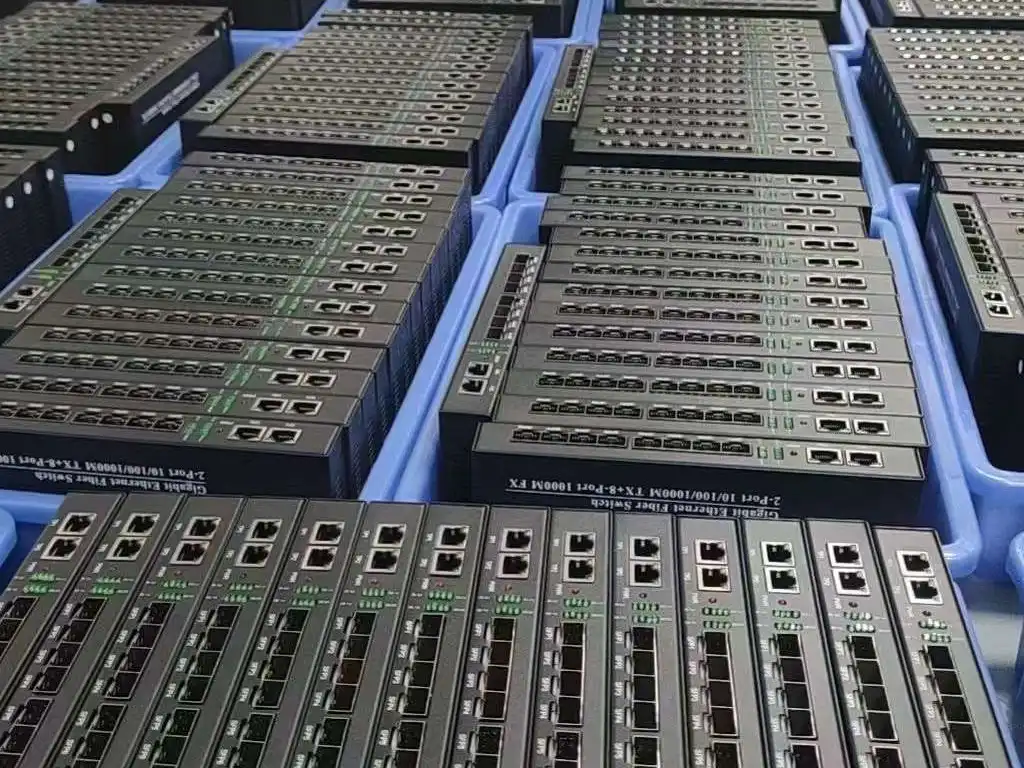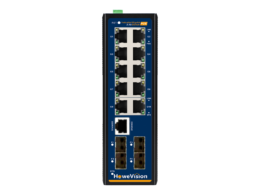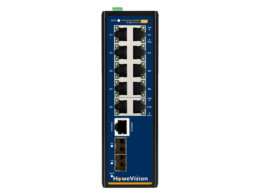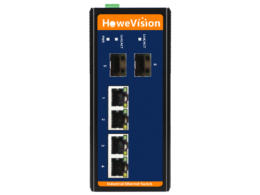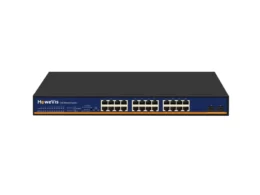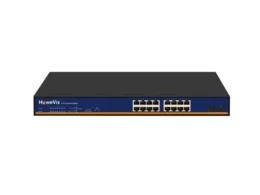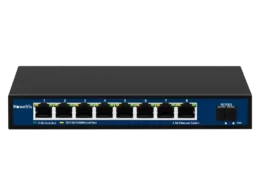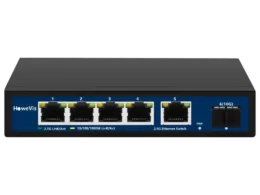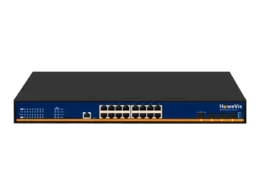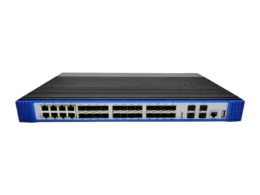In the rapidly evolving landscape of network technology, finding a reliable PoE switch supplier has become crucial for us. Our journey through the intricacies of Power over Ethernet (PoE) solutions has taught us the importance of quality and efficiency in these devices. As professional network engineers, we’ve seen firsthand how the right PoE switch can revolutionize our infrastructure, offering power and data connectivity to devices with a single cable. This technological marvel, stemming from the early 2000s, has become indispensable in our toolkit. We understand that navigating the myriad options can be daunting, so we’re here to share our insights and experiences to help you make an informed decision.
Key Takeaways
- Understanding the variety of PoE switches available when selecting a supplier is crucial for making an informed decision that meets your needs.
- The choice between managed and unmanaged PoE switches significantly impacts network control and flexibility, with managed switches offering more features for complex networks.
- Industrial PoE switches provide robust advantages for challenging environments, highlighting the importance of considering your operational context when choosing a supplier.
- Familiarizing yourself with the diverse applications of PoE technology can help you better assess the capabilities and quality of potential suppliers, as demonstrated by the versatility of the HoweVision PoE Switch.
- Practical considerations such as installation ease, configuration simplicity, and maintenance requirements are essential in selecting a supplier that will ensure long-term performance and reliability.
- Real-world success stories are valuable testimonials of a supplier’s quality and reliability, making them a critical aspect to review before finalizing your choice.
Understanding PoE Switch Varieties
PoE Types
We quickly learned about the different types of Power over Ethernet (PoE) switches when we set up a robust network system. These devices are not just about providing power; they’re about doing so efficiently and effectively for various devices. The basic types include PoE, PoE+, and UPoE.
PoE, governed by the IEEE 802.3af standard, was our starting point. It delivers up to 15.4W of DC power to each device. This seemed adequate for low-power devices like IP cameras or VoIP phones.
Then we discovered PoE+, based on the IEEE 802.3at standard. It can supply up to 30W per port, making it suitable for slightly more demanding devices such as dual-band wireless access points.
The revelation came with UPoE (Universal Power over Ethernet). It doubles the power provision to an impressive 60W per port. We found it perfect for high-power setups like video phones or compact switches.
Power Requirements
Understanding our devices’ power requirements became crucial in selecting the right type of PoE switch. We realized it wasn’t just about ensuring connectivity and providing sufficient power without overloading the system.
We began by listing all our devices and their power needs. This exercise helped us see that not all devices required the same level of power provision.
For instance, our surveillance cameras worked fine with standard PoE switches. However, our high-performance Wi-Fi access points needed a PoE+ switch to function correctly.
This step was eye-opening for us. It underscored the importance of matching device requirements with switch capabilities to avoid underpowering or unnecessary expenses.
Standards Role
The role of standards like IEEE 802.3af and IEEE 802.3at in defining PoE capabilities cannot be overstated. These standards were like a beacon guiding us through the dense fog of technical specifications and marketing jargon.
IEEE 802.3af clarified which devices could be powered using standard PoE switches. Knowing this allowed us to make informed decisions for our less demanding devices.
Similarly, IEEE 802.3at’s specifications clarified what we could expect from PoE+ switches. This knowledge was pivotal in planning our network setup for medium to high-power devices.
These standards ensured compatibility across different brands and models, making them indispensable in our decision-making process.
Managed vs. Unmanaged PoE Switches
Benefits Managed
In our journey to optimize our network, we’ve discovered the undeniable advantages of managed PoE switches. These devices offer us unparalleled control and monitoring capabilities.
Firstly, they allow us to tailor network performance to our specific needs. By enabling us to configure VLANs, we can segment traffic effectively. This segmentation boosts efficiency and enhances security.
Secondly, managed PoE switches provide us with comprehensive monitoring tools. These tools are crucial for spotting and diagnosing issues before they escalate. They give us insights into traffic patterns, helping us make informed decisions about network management.
Lastly, remotely managing these switches has been a game-changer for us. It means we can adjust settings or troubleshoot problems from anywhere, at any time. This flexibility is invaluable in maintaining a robust and reliable network.
Simplicity Unmanaged
On the other hand, unmanaged PoE switches have their own appeal. Their simplicity and cost-effectiveness make them an attractive option for smaller networks.
Unmanaged PoE switches are plug-and-play devices. Wet can set them up quickly without needing specialized knowledge or skills. Their straightforward nature eliminates complexity from our network setup.
Moreover, these switches are more budget-friendly than their managed counterparts. When our needs are basic, it’s hard to justify the additional expense of a managed switch. Unmanaged PoE switches offer a practical solution that meets our requirements without breaking the bank.
The lack of configuration options in unmanaged switches translates to fewer potential points of failure. This simplicity can increase reliability in specific scenarios where minimal intervention is preferred.
Preferred Scenarios
Given the distinct features of managed and unmanaged PoE switches, explicit scenarios exist where one might be preferred over the other.
Managed PoE switches are indispensable for environments requiring high levels of customization and control, such as large enterprise networks or data centers. Their advanced features efficiently support complex applications like VoIP phones or surveillance cameras.
In contrast, unmanaged PoE switches shine in smaller setups where simplicity is key. Small offices or home networks benefit from their easy deployment and maintenance-free operation. Here, the primary goal is to connect devices with minimal fuss rather than fine-tune performance or monitor traffic closely.
However, it’s not always black and white. Sometimes, a hybrid approach works best. For instance, deploying managed PoE switches at the core of our network while using unmanaged ones at the edges can strike a balance between control and cost-effectiveness.
Industrial PoE Switch Advantages
Durability
In our experience, industrial PoE switches stand out significantly in terms of durability. These devices thrive in environments that would quickly degrade standard equipment.
Industrial PoE switches are built to withstand extreme conditions. They endure high levels of vibration, shock, and exposure to dust and moisture. This resilience ensures operations continue smoothly, without interruption.
Moreover, these switches often come with rugged features, including enclosures designed to protect internal components from physical damage and environmental hazards. Such robustness is critical for maintaining network integrity in industrial settings.
Their construction materials are also a factor. Manufacturers typically use metals that are highly resistant to corrosion and wear. This further extends the lifespan of the devices, making them a reliable choice for challenging environments.
Temperature Range
Another key advantage lies in their extended temperature ranges. Unlike standard models, industrial PoE switches operate effectively across a broader spectrum of temperatures.
These devices can function in icy conditions and in hot environments where temperatures soar beyond what typical electronics can handle. This capability is crucial for industries in regions experiencing severe weather or outdoor applications exposed to the elements.
The extended temperature range ensures stable network access even under adverse conditions. It prevents system failures caused by overheating or freezing, safeguarding data transmission and power supply continuity.
Temperature resilience enhances reliability and reduces the need for additional cooling or heating systems. This results in cost savings and simplifies installation and maintenance processes.
Uninterrupted Power
One of the most significant benefits of industrial PoE switches is their ability to ensure an uninterrupted power supply alongside data transmission. This dual functionality is essential for maintaining operational efficiency and safety in many sectors.
Industrial PoE switches deliver power over Ethernet (PoE) to connected devices such as cameras, sensors, and wireless access points. This eliminates the need for separate power cables, simplifies infrastructure, and reduces clutter.
The provision of power through Ethernet cables enables centralized control over power distribution. It allows for remote device rebooting and easy implementation of backup power solutions. These features help maintain critical functions in a power outage until normal conditions are restored.
Furthermore, some models come equipped with extra gigabit TP ports. These ports expand connectivity options and enhance network flexibility, accommodating a greater number of devices without sacrificing speed or efficiency.
Exploring PoE Applications
VoIP Phones
In our journey to understand the impact of Power over Ethernet (PoE), we’ve seen its crucial role in powering devices central to our daily operations. VoIP phones stand out as a prime example. These devices, essential in modern communication infrastructures, thrive on PoE’s simplicity and efficiency.
By supplying power and data connectivity through a single cable, PoE eliminates the need for additional power sources. This not only simplifies installation but also reduces clutter and enhances the aesthetic appeal of workspaces. The convenience is unmatched, especially when setting up or rearranging office layouts.
Moreover, the reliability of PoE ensures that VoIP phones remain operational even in power outages, provided the PoE switch is connected to an uninterruptible power supply (UPS). This continuity is vital for maintaining communication channels open during critical moments.
IP Cameras
Security systems have evolved significantly with the advent of IP cameras, another beneficiary of PoE technology. The ease of deployment allows us to place these cameras in optimal locations without worrying about proximity to electrical outlets. This flexibility dramatically enhances security measures by covering previously inaccessible areas.
The streamlined cabling also leads to cost savings in installation and maintenance. The complexity and labor involved in setting up a comprehensive surveillance system are notably reduced with fewer cables.
Furthermore, the scalability offered by PoE makes future expansions less daunting. Adding new cameras to the network involves minimal disruption and expense, allowing for adaptive security strategies that evolve with our needs.
Wireless Access Points
Wireless access points (WAPs) are pivotal in creating robust wireless networks. Again, PoE proves indispensable by facilitating quick deployments and relocations. Powering WAPs through Ethernet cables allows us to optimize their placement for maximum coverage and performance.
This versatility is particularly beneficial in environments where mobility is critical. Schools, hospitals, and large retail spaces reap significant advantages from being able to adjust their network infrastructure as demands change.
PoE’s energy efficiency minimizes operational costs. By delivering precisely the amount of power needed by each device, waste is reduced, contributing to greener technology solutions.
Smart Buildings
PoE emerges as foundational as we embrace intelligent building technologies and Internet of Things (IoT) deployments. It powers a wide array of sensors and actuators that make buildings more intelligent—efficiently regulating lighting, temperature, and security systems.
This integration leads to more intelligent energy management and enhanced occupant comfort. The centralized control enabled by PoE-powered devices simplifies monitoring and adjustments while reducing overall energy consumption.
The adaptability of PoE supports innovative applications within intelligent buildings. From environmental monitoring to automated resource management, it lays the groundwork for buildings that connect and respond intelligently to their inhabitants’ needs.
Cost Savings
Reflecting on our exploration of PoE applications, it’s clear that financial considerations play a significant role beyond technical benefits. Consolidating power and data into a single cable infrastructure represents substantial cost savings in materials and labor.
These savings extend into ongoing operational expenses as well. Energy-efficient designs coupled with streamlined maintenance requirements contribute to lower total cost of ownership for networked devices.
Selecting the Right PoE Switch
Power Requirements
When we set up our network, one crucial step was understanding the total power requirements of our connected devices. This wasn’t just about plugging in numbers; it involved a deep dive into each device’s power needs, from ethernet switches to the NR outdoor gateway harnesses that would form the backbone of our connectivity.
We quickly realized that not all PoE switches are created equal. Some could offer up to 30 watts per port, while others might provide more or less. It became apparent that calculating the total wattage needed was essential. We had to ensure that the switch we chose could handle the cumulative demand of all our devices without breaking a sweat.
Moreover, we learned that efficiency matters. A switch that barely meets current demands leaves no room for additional devices. We aimed for a switch offering extra capacity beyond our immediate needs. This foresight would save us from future headaches as our network grew.
Network Expansion
Looking toward the future was another critical aspect of our selection process. We knew our adventure wouldn’t stop with the current setup; expansion was inevitable. Choosing a PoE switch with scalability in mind became a priority.
We considered switches that offered more ports than we currently needed. This approach meant we wouldn’t have to purchase an entirely new switch when adding more devices later. We also looked at modular PoE switches, which allowed us to add extra capacity as required.
The concept of future-proofing our network played a significant role here. Opting for ethernet switches capable of supporting higher speeds and newer standards ensured we weren’t left behind as technology advanced.
Compatibility Concerns
Our journey also taught us the importance of compatibility between the new PoE switch and our existing network equipment. We had various devices, each with its specifications and requirements.
Ensuring that the new switch supported all current network standards was non-negotiable. We couldn’t afford disruptions caused by incompatibility issues. It was essential for seamless integration into our existing setup without needing extensive modifications or replacements.
Moreover, we discovered the significance of choosing a switch that could communicate effectively with our network’s older and newer devices. This backward compatibility ensured that even as we upgraded some parts of our system, they would still work harmoniously with legacy equipment.
HoweVision PoE Switch
PoE Introduction
Power over Ethernet (PoE) technology revolutionizes how we power devices through a single Ethernet cable, transmitting data and power. It simplifies wiring and reduces costs, making it an indispensable tool in modern networking. We’ve seen its efficiency in deploying network cameras, VoIP phones, and Wi-Fi access points without additional power sources.
This technology streamlines installation processes and enhances flexibility by eliminating the dependency on electrical outlet proximity. Its cost-effectiveness is evident in the initial setup and maintenance phases, proving invaluable across various sectors.
The adaptability of PoE to support numerous devices underscores its critical role in our networking solutions. This versatility attracted us to explore HoweVision’s range of PoE switches, which are known for their reliability and performance.
HoweVision’s Range
We discovered that HoweVision is a PoE switch supplier, offering a comprehensive portfolio of switches designed to meet diverse industrial needs. Their products boast high reliability and performance, which is ideal for sectors demanding robust networking solutions like manufacturing, security, healthcare, and education.
Their offerings include OEMethernet switches and industrial switch manufacturers from China, highlighting their capability to cater to specific project requirements with customized solutions. This aspect was particularly appealing as it allowed us to tailor our network infrastructure precisely to our operational needs.
Moreover, HoweVision’s commitment to innovation is evident in its energy-efficient designs and scalable solutions. These features ensure long-term sustainability and provide the security enhancements necessary for today’s digital landscape.
Innovation in Technology
HoweVision’s innovative approach to PoE technology sets it apart from competitors. It prioritizes energy efficiency without compromising scalability or security—a balance hard to find elsewhere.
Cutting-edge features like advanced power management and robust data transmission capabilities bolster their industrial switch supplier credentials. These attributes make their switches highly suitable for applications requiring uninterrupted service and high data throughput.
Furthermore, integrating media converter manufacturer expertise allows seamless conversion between different media types, enhancing network flexibility. This is crucial for us as it enables the effortless incorporation of fiber connections into our infrastructure.
Application Success
We’ve witnessed remarkable success stories where HoweVision’s PoE switches significantly improved operational efficiency and reliability across various industries. One notable instance involved a large-scale surveillance system upgrade for a manufacturing facility. The deployment of HoweVision’s SFP switch manufacturer products ensured seamless video transmission over long distances without signal degradation.
Another case involved implementing their switches in a healthcare setting, where reliable network performance is non-negotiable. The PoE switches’ ability to deliver consistent power and data flow significantly improved patient care technologies’ responsiveness and reliability.
These real-world applications highlight the technical superiority of HoweVision’s products and their tangible impact on improving daily operations across different sectors.
Installation Tips
For those considering integrating HoweVision’s PoE switches into their networks, we recommend meticulously planning your network layout. Consider device power requirements and cabling infrastructure to maximize your investment’s potential.
Regular firmware updates are crucial for maintaining security measures up-to-date and ensuring your network remains protected against emerging threats.
Lastly, don’t overlook the importance of proper ventilation around your switches to prevent overheating—this simple step can significantly extend your equipment’s lifespan.
Installation and Configuration Tips
Planning Layout
We’ve learned that planning the layout is crucial for optimizing PoE deployment. It’s not just about plugging devices into the nearest switch. We consider the total power requirements of all connected devices to ensure our electrical equipment, including the HoweVision PoE Switch, can handle the load.
The design house we collaborated with emphasized creating a detailed map. This map accounts for all wireless network connections and physical placements of devices. We discovered that strategic placement reduces cable clutter and ensures efficient power distribution.
Moreover, we found including future expansion plans in our initial layout beneficial. This foresight prevents costly overhauls when adding new devices or upgrading existing ones.
VLANs and QoS
Configuring VLANs (Virtual Local Area Networks) and QoS (Quality of Service) on managed PoE switches like HoweVision’s has been a game-changer for us. These configurations allow us to segment our network for better security and prioritize traffic for critical applications.
Setting up VLANs helps us isolate sensitive data and manage network traffic more effectively. For instance, we dedicate one VLAN for our video surveillance systems, ensuring high bandwidth availability away from regular office data traffic.
QoS settings are equally important. They let us prioritize voice over IP (VoIP) and video conferencing traffic over less sensitive data transfers. This prioritization ensures smooth, lag-free communications, which is essential in today’s remote working environment.
We learned that mastering these configurations requires patience and a deep dive into the full details provided by art network solutions like HoweVision. Their guides have been instrumental in helping us fine-tune our settings for optimal performance.
Common Pitfalls
Throughout our journey, we encountered several common pitfalls during installation. First was underestimating power requirements, which led to unexpected downtimes. We now know the importance of calculating the power budget meticulously before adding new devices to our network.
Another pitfall was neglecting firmware updates on our PoE switches. Keeping firmware updated is vital as it often includes fixes for known issues and performance and security feature improvements.
Lastly, we initially overlooked the importance of a well-documented network design. Troubleshooting becomes a nightmare without proper documentation, especially when dealing with complex networks involving multiple devices and connections.
Maintenance for Optimal Performance
Firmware Updates
After setting up our PoE switch, ensuring its optimal performance became our next priority. Regular firmware updates stood out as a crucial step in this process. They enhance security and overall functionality.
Manufacturers often release firmware updates to address vulnerabilities and introduce new features. Ignoring these updates can expose our network to risks. Thus, we made it a point to check for updates periodically and apply them promptly.
The process involved logging into the switch’s web interface, checking the current firmware version, and comparing it with the latest one on the supplier’s website. We downloaded the file and followed the instructions if an update was needed. This task required attention to detail to avoid disruptions during the update process.
Health Monitoring
Monitoring the health of our PoE devices became another essential routine. It helped us identify potential issues early and ensure efficient power consumption. We utilized technology that allowed real-time monitoring of each device connected to our PoE switch.
This capability enabled us to view detailed metrics about power usage, helping us manage costs effectively. We could see which devices consumed more power than expected and make necessary adjustments. It also alerted us to abnormal behavior that might indicate a device or connection problem.
We used tools provided by our PoE switch supplier or third-party solutions compatible with our system for accurate monitoring. These tools offered dashboards where we could easily access all relevant information at a glance.
Cable Checks
Periodic checks of cabling and connections were vital in preventing power issues that could disrupt our network’s operation. Over time, cables can suffer from wear and tear or become loosely connected, leading to intermittent power supply problems.
We scheduled regular inspections of all cables connected to our PoE switch. This included verifying that each cable was securely plugged in and checking for any signs of damage or wear. Replacing faulty cables promptly ensured a stable power supply to all devices.
These checks also allowed us to organize our cables better, reducing clutter and improving airflow around equipment—a small but significant step towards maintaining an optimal operating environment for our devices.
Real-World Success Stories
Network Efficiency
We’ve witnessed firsthand how businesses have transformed their operations by integrating PoE switches into their networks. These changes aren’t just about numbers on a spreadsheet; they’re about real people experiencing daily tangible benefits.
One standout example involves a mid-sized retail chain. They faced constant network outages and inefficiencies, hampered sales and customer satisfaction. They overhauled their network infrastructure after partnering with a leading PoE switch supplier. The results were immediate. Sales processes became smoother, and the overall customer experience improved significantly. This wasn’t just an upgrade and revolution in how they conducted business.
Another case saw a local school district grappling with outdated technology that limited digital learning opportunities for students. The introduction of PoE switches not only streamlined internet access but enabled the deployment of smart boards in every classroom. Teachers now deliver interactive lessons, engaging students in previously impossible ways. It’s clear that these switches are not just tools; they’re gateways to new educational horizons.
Innovative Uses
The versatility of PoE technology shines through its innovative applications across various industries. In healthcare, hospitals utilize PoE switches to power and connect vital monitoring equipment. This has ensured uninterrupted patient care and facilitated rapid medical data sharing among professionals, improving response times in critical situations.
Retailers have leveraged PoE to enhance customer experiences through dynamic digital signage and seamless Wi-Fi connectivity throughout stores. These innovations have turned casual browsing into immersive shopping adventures, often increasing sales and brand loyalty.
Perhaps most impressively, stable partnerships between suppliers and customers have led to custom PoE solutions for unique industry challenges. For instance, agriculture firms now monitor crop conditions in real time using sensors powered by PoE switches, enabling precise interventions that boost yields and reduce waste.
Security Enhancement
The impact of PoE on security systems cannot be overstated. With the rise of IP surveillance cameras, ensuring continuous operation is paramount for safety and security. Our collaborations with brand customers have showcased this technology’s ability to provide reliable power supply and data transmission over a single cable, simplifying installation and maintenance while enhancing system reliability.
A notable success story comes from a large manufacturing plant where theft incidents had been rising alarmingly. After installing high-definition IP cameras powered by robust PoE switches, they experienced a drastic reduction in thefts. The clarity of footage allowed for easy identification of perpetrators, serving as both a deterrent and an effective tool for law enforcement.
Moreover, urban developments have adopted integrated security solutions powered by PoE technology to create safer public spaces. Lighting systems, emergency call stations, and surveillance cameras all work seamlessly together thanks to the reliable power supply from PoE switches.
Summary
Navigating the realm of PoE switches, we’ve dissected various types, from managed to unmanaged and industrial advantages, down to their pivotal role in real-world applications. Our journey through understanding the nuances of selecting the right HoweVision PoE switch, coupled with tips for installation, configuration, and maintenance, underscores our commitment to ensuring optimal performance for any setup. We’ve shared success stories to illustrate the transformative impact of these devices across diverse environments.
Let’s elevate our networks together. Embrace the power and flexibility of PoE switches with us. Dive into the world of seamless connectivity and robust performance. Choose expertise, choose reliability—choose us for your next project. Let’s craft success stories together. Reach out now, and let’s embark on this journey towards technological excellence together.
Frequently Asked Questions
What varieties of PoE switches are available?
Several types include managed, unmanaged, and industrial PoE switches. Each serves different network needs and complexities.
How do managed and unmanaged PoE switches differ?
Managed PoE switches offer more control and flexibility over your network, allowing for configuration and management. Unmanaged switches are plug-and-play with no setup required.
What are the advantages of industrial PoE switches?
Industrial PoE switches are designed for harsh environments. They offer durability, extended temperature ranges, and reliability in critical applications.
Can you use PoE switches in any application?
Yes, PoE switches support various applications, from VoIP phones to security cameras, making them versatile for various industries.
How do I select the right PoE switch for my needs?
Consider your network size, power requirements, environment, and whether you need manageability features. Understanding these factors will guide your choice.
Are there tips for installing and configuring a PoE switch?
Yes. Always plan your network layout carefully, update the latest firmware, and ensure proper ventilation for optimal performance.
How can I maintain my PoE and Ethernet switches with gigabit TP ports for optimal performance and stable network connectivity?
Regularly check for firmware updates, monitor network traffic for anomalies, and clean dust from ports to maintain efficiency and longevity.

